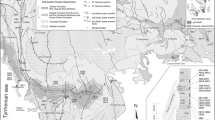Abstract
Eskola's concept of metamorphic facies, now 50 years old, is reappraised in the light of current knowledge and usage among petrologists. Facies should be defined solely in terms of observable geologic criteria. LikeEskola, we continue to view each facies as a set of mineral assemblages that approximate equilibrium within a definite range of temperature; but this is inference and must be excluded from the definition of facies.
Mutual boundaries between facies are transitional. Division into subfacies has proved unacceptable to many writers, and has led to confusion in the physical interpretation of metamorphic parageneses. We propose henceforth not to recognize subfacies.
Eleven facies are recognized in this paper, and their terminology has been adapted as nearly as possible to current general usage:
-
A.
Low-pressure facies commonly but not exclusively of contact metamorphism. In order of increasing temperature:
-
(1)
Albite-epidote-hornfels.
-
(2)
Hornblende-hornfels.
-
(3)
Pyroxene-hornfels.
-
(4)
Sanidinite.
-
(1)
-
B.
High-pressure low-temperature facies of regional metamorphism. In order of increasing pressure:
-
(5)
Zeolitic.
-
(6)
Greenschist.
-
(7)
Glaucophane-lawsonite-schist.
-
(5)
-
C.
High-pressure medium- to high-temperature facies of regional metamorphism. In order of increasing temperature:
-
(8)
Albite-epidote-amphibolite.
-
(9)
Amphibolite.
-
(10)
Granulite.
-
(8)
-
D.
Facies of extreme pressure and wide temperature range:
-
(11)
Eclogite.
-
(11)
The pressure-temperature regime of a metamorphic terrane can be discussed in terms of the facies there represented, with detailed gradients inferred from sequences of mineral assemblages in basic, pelitic and calcareous rocks. The general simplicity of metamorphic mineral assemblages and their tendency to recur in space and time suggests a simple relation between such theoretically independent pressure variables as load pressureP l fluid pressureP j partial pressure of water,\(P_{{\text{H}}_{\text{2}} {\text{O}}}\). As a first approximation we accept for non-carbonate, hydrous assemblages a model in which\(P_{{\text{H}}_{\text{2}} {\text{O}}}\)≃P f ≃P l during mineral reactions.
Similar content being viewed by others
Literature
Banno, S.: Petrologic studies on Sanbagawa crystalline schists in the Bessi-Ino district, Central Sikoku, Japan. J. Fac. Sci., Univ. Tokyo, sect, ii,15, 203–319 (1964).
Becke, F.: Zur Facies-Klassifikation der metamorphen Gesteine. Tschermak's mineral, u. petrog. Mitt.35, 213–230 (1921).
Billings, M. P.: Comment on “Structural and petrologic studies in Dutchess County, New-York, part II” (T. F. W. Barth). Bull. Geol. Soc. Amer.47, 2000–2003 (1963).
Campbell, A. S., andW. S. Fyfe: Analcime-albite equilibria. Am. J. Sci.263, 807–816 (1965).
Chinner, G. A.: The kyanite isograd in Glen Cova, Angus, Scotland. Mineral. Mag.34, 132–143 (1965).
Crawford, W. A., andW. S. Fyfe: Lawsonite equilibria. Am. J. Sci.263, 262–270 (1965).
De Roever, W. P.: Igneous and metamorphic rooks in eastern central Celebes. Geological explorations in the island of Celebes, p. 65–173. Amsterdam: North-Holland Publ. Co. 1947.
—: Preliminary notes on glaucophane-bearing and other crystalline schists from southeast Celebes. Koninkl. Ned. Akad. Wetenschap. Proc.53, No. 9, 1–12 (1950).
Ernst, G.: Stability relations of glaucophane. Am. J. Sci.259, 735–765 (1961).
Eskola, P.: On the relations between the chemical and mineralogical composition in the metamorphic rooks of the Orijärvi region. Comm. Geol. Finlande Bull.44, 1–107 [in Finnish], 109–145 [in English] (1915).
—: Die metamorphen Gesteine. Die Entstehung der Gesteine (T. F. W. Barth, C. W. Correns andP. Eskola), S. 263–407. Berlin: Springer 1939.
Evans, B. W.: Application of a reaction-rate method to the breakdown equilibrium of muscovite and muscovite plus quartz. Am. J. Sci.263, 647–667 (1965).
—, andC. V. Guidotti: The sillimanite-potash feldspar isograd in Western Maine. Contr. Mineral. and Petrol.12, 25–62 (1966).
Francis, G. H.: Facies boundaries in pelites in the middle grades of regional metamorphism. Geol. Mag.93, 353–368 (1956).
Fyfe, W. S., F. J.Turner, and J.Verhoogen: Metamorphic reactions and metamorphic facies. Geol. Soc. Am. Mem.73 (1958).
Ghent, E. D.: Glaucophane-schist facies metamorphism in the Black Butte area, northern Coast Ranges, California. Am. J. Sci.263, 385–400 (1965).
Harker, R. I., andO. F. Tuttle: Experimental data on the\({\text{P}}_{{\text{CO}}_{\text{2}} }\)-T curve for the reaction: calcite+quartz=wollastonite+carbon dioxide. Am. J. Sci.254, 239–256 (1956).
Kennedy, W. Q.: Zones of progressive regional metamorphism in the Moine schists of the western Highlands of Scotland, Geol. Mag.86, 43–56 (1949).
Kretz, R.: Some applications of thermodynamics to coexisting minerals. J. Geol.69, 361–387 (1961).
Lambert, R. St. J.: The metamorphic facies concept. Mineral. Mag.34, 283–291 (1965).
Mathews, R. T.: The greenstones of the Petrie-Mount Mee area, Queensland. Univ. Queensland Papers, Dept. Geol.4, No. 6 (1954).
Miyashiro, A.: Evolution of metamorphic belts. J. Petrology2, 277–311 (1961).
Segnit, R. E., andG. C. Kennedy: Reactions and melting relations in the system muscovitequartz at high pressures. Am. J. Sci.259, 280–287 (1961).
Thompson, J. B.: The thermodynamic basis for the mineral facies concept. Am. J. Sci.253, 65–103 (1955).
Tilley, C. E.: The facies classification of metamorphic rocks. Geol. Mag.61, 167–171 (1924).
Turner, F. J.: Mineralogical and structural evolution of the metamorphic rocks. Geol. Soc. Am. Mem.30 (1948).
—, andJ. Verhoogen: Igneous and metamorphic petrology. New York: McGraw-Hill Book Co. 1961.
Tuttle, O. F., and N. L.Bowen: The origin of granite in the light of experimental studies in the system NaAlSi3O8-H2O. Geol. Soc. Am. Mem.74, (1958).
Vogt, T.: Sulitelmafeltets geologi og petrografi (with English summary). Norges Geol. Undersk.121 (1927).
White, W. S., andM. P. Billings: Geology of the Woodsville Quadrangle, Vermont-New Hampshire. Geol. Soc. Am. Bull.62, 647–696 (1951).
Winkler, H. G. F.: Petrogenesis of metamorphic rocks. Berlin-Göttingen-Heidelberg: Springer 1965.
Yoder, H. S., andC. E. Tilley: Origin of basalt magmas: An experimental study of natural and synthetic rock systems. J. Petrology3, 342–532 (1962).
Zwart, H. J.: Some examples of the relations between deformation and metamorphism from the central Pyrenees. Geol. en Mijnbouw42, 143–154 (1963).
Author information
Authors and Affiliations
Rights and permissions
About this article
Cite this article
Fyfe, W.S., Turner, F.J. Reappraisal of the metamorphic facies concept. Contr. Mineral. and Petrol. 12, 354–364 (1966). https://doi.org/10.1007/BF00616820
Received:
Issue Date:
DOI: https://doi.org/10.1007/BF00616820




